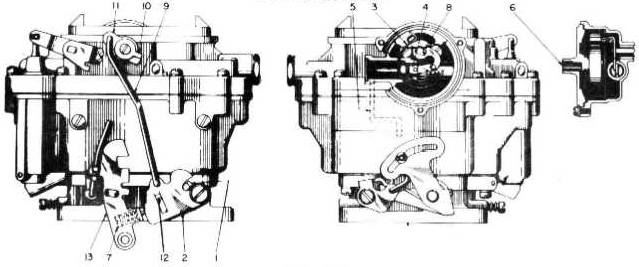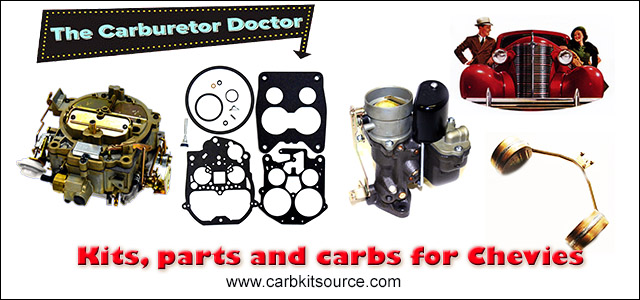|
ROCHESTER CARBURETORS Bulletin 9D-9 January 1952 |
||||
|
Page 10
ROCHESTER PRODUCTS, DIVISION OF GENERAL MOTORS, ROCHESTER,
NEW YORK |
||||
|
|
||||
|
CHOKE SYSTEM |
||||
|
|
||||
|
|
||||
|
|
||||
|
Figure 7-6 |
||||
|
|
||||
|
Use Figure 7-6 as a
reference.
The Model
4GC Carburetor employs the use of a fully automatic choke to insure proper
starling and driving during cold weather operation. Choking of the
carburetor is necessary only on the primary or pump side. This is due to the fact that the
secondary throttle valves are
locked in the closed position whenever the choke valve is even partially closed. This
is accomplished by a
secondary throttle shaft lock out lever (1) and a slot in the fast idle
cam (2). Whenever the choke valve is closed the lock out lever prevents
opening of the secondary
throttle valves. However, when the choke valve is wide open, the fast idle cam
drops down so that the lock
out lever clears the cam, thus permitting the secondary
throttle valves to open.
The choke system is composed of a
thermostatic coil (3), vacuum piston (4), offset choke valve, and fast
idle cam (2). Its operation is
controlled by a combination of intake manifold vacuum the offset choke
valve atmospheric temperature,
and exhaust manifold heat.
When the engine is cold the
thermostatic coil is calibrated to hold the choke valve closed. As
the engine is started, air velocity
against the offset choke valve causes the valve to open slightly
against the torque of the thermostatic coil. In addition, intake manifold
vacuum is applied to the vacuum piston (4), through the vacuum
channel (5) which also tends
to open the choke valve. Therefore, the choke valve assumes a position
where the torque of the thermostatic coil is balanced against vacuum pull
upon the choke piston and air
velocity against the offset choke valve thereby causing a regulated air flow into the carburetor which provides
a richer mixture during the
warm-up period.
During warm-up the Vacuum piston
(4) serves to modify the choking action to compensate for varying engine loads or acceleration. Any
acceleration or in- |
creased road load decreases the
vacuum exerted on the choke piston.
This allows the thermostatic coil torque to momentarily increase
choke valve closure to provide the
engine with a richer mixture for acceleration.
As the engine warms up, hot air from the exhaust manifold is
drawn into the thermostatic coil housing through (6). This hot air causes
a rise in temperature which in turn causes the coil to slowly relax its tension. Thus the choke valve is
allowed to move gradually to the full open position.
To prevent stalling during the
warm-up period, it is necessary to run
the engine at a slightly higher idle speed than for a warm engine.
This is accomplished by the fast idle screw (7) which rests on the steps of the
fast idle cam (2). The fast
idle cam is in turn linked to the choke valve shaft (8) by the choke rod (9), choke trip lever (10) and choke lever and
collar assembly (11) and holds the throttle valves open
sufficiently during the
warm-up period to give the increased idle RPM, until the choke valve moves to the full open
position.
While the automatic choke is in
operation the driver may wish to advance the throttle to the full wide
open position. Since this would decrease pull upon the vacuum piston
(4) thereby closing the choke
valve, it is necessary to provide increased carburetor air flow by opening the choke valve
mechanically. 'To accomplish
this, a tang (1 2) on the fast idle cam (2) is made to contact the
throttle lever (13) at wide open throttle position so as to
sufficiently open the choke valve. This is also called a choke unloader and serves to
dechole a flooded carburetor during cold starting operation. This
choke unloader will also
relieve a Hooded condition on starting by allowing more air to enter the carburetor and mix
with the excess gasoline in the manifold whenever the engine is
cranked with the accelerator
held fully
depressed. |
|||
|
|
||||

